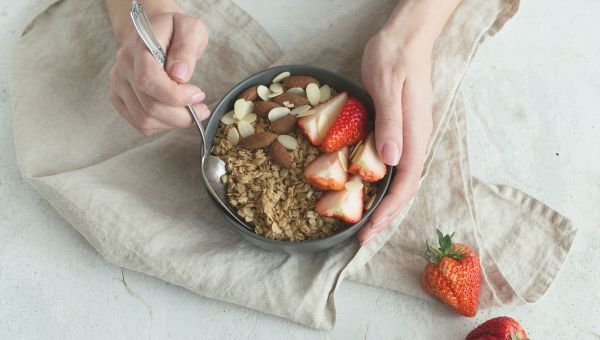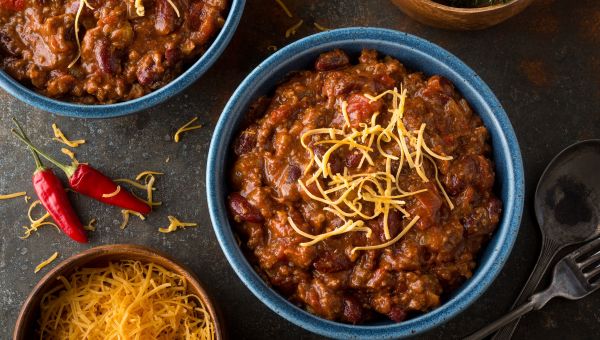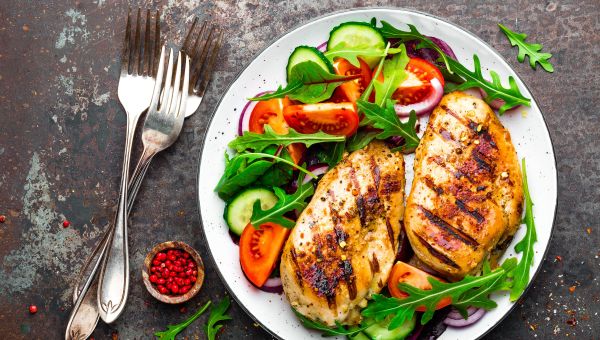6 tips for healthy eating with COPD
Chronic obstructive pulmonary disease makes breathing difficult, but a few simple changes to your diet may help.
Updated on May 5, 2022

Chronic obstructive pulmonary disease (COPD) is a progressive condition that makes breathing hard, and there is no cure. It affects over 15 million Americans, and can cause coughing that produces mucus, wheezing, and shortness of breath. In 2021, this condition was the fifth leading cause of death due to medical illness in the United States.
The condition can be treated with medication, pulmonary rehabilitation, oxygen therapy, and surgery. Some healthy habits can make these treatments more effective. Kicking your tobacco habit, maintaining a healthy weight, and stocking your fridge with COPD-friendly eats are good places to start.
There’s no specific diet for COPD but adopting certain strategies and avoiding foods that trigger symptoms can help. Here’s what you need to know about eating well with COPD, with insights from Trenton Nauser, MD, director of pulmonary medicine with Menorah Pulmonary and Critical Care Consultants in Overland Park, Kansas.

Snack on smaller meals
Shortness of breath is one of the most common symptoms of COPD, and large meals can make it worse. There are two main reasons you may struggle to breathe after a large meal. First, as food enters your stomach, it expands. A whopping meal can cause the stomach to swell and press against the lungs. This can make inhaling and exhaling a challenge.
The second? “Large meals produce a great deal of carbon dioxide that has to be breathed out, so the amount of work that has to be done to breathe increases,” Dr. Nauser says.
One simple solution is to eat smaller portions. The American Lung Association recommends eating between four and six smaller meals throughout the day. So, stock your fridge, work area, and even your purse with healthy snacks to munch anytime hunger strikes.

Avoid foods that make you gassy
Portion size matters, but so do the types of foods you eat. Certain foods, even in small quantities, can cause gas and bloating, which can put a strain on your breathing. “Avoid foods that lead to abdominal distention and make you feel bloated, because it can aggravate your breathing,” Nauser recommends.
Greasy, fried foods digest slowly; the extra time they take to digest can cause gas to build up inside your digestive tract. Foods like beans, cabbage, lentils, and broccoli are major gas producers, so it may be a good idea to limit your consumption (if you find they bother you).
Not all causes of belly bloat are so obvious, however. Carbonated beverages and chewing gum allow excess air into the body, which can make you a bit gassier than usual.
Although cutting out some of these foods is one way to improve your breathing, Nauser warns that completely eliminating any food from your diet could be potentially dangerous for your overall health. Our bodies thrive on a variety of nutrients, so speak with your healthcare provider (HCP) before swearing off entire food groups.

Load up on fruits and veggies
Fruits and veggies are the cornerstone of any healthy diet, but nutrient-rich produce may be especially important if you have COPD. Research has linked oxidative stress to inflammation in the airways and other parts of the respiratory system.
Oxidative stress is an imbalance between harmful free radicals and antioxidants, or substances that help protect your body’s cells from damage. COPD has been characterized by an increase in inflammation throughout the body. Relieving inflammation—with the help of antioxidants or otherwise—may help improve the condition.
Results from a study published in 2021 in the journal Nutrients suggest an association between antioxidant-rich diets and improvement of lung function in those with COPD. The study included 105 people with severe COPD who were age 70 years and over. Results showed that participants who ate more vegetables in their daily diets benefited more from three weeks of pulmonary rehab, compared to those who ate very little vegetables. Antioxidants are abundant in foods like apples, berries, asparagus, sweet potatoes, and dark green leafy vegetables like spinach and kale.
Give your diet an antioxidant boost by adding dishes like sweet mixed berry salsa and flavorful roasted asparagus to your repertoire.

Limit your sodium intake
Sodium is a mineral your body needs, but too much could hurt your health. Sodium is found in canned soup and packaged goods, among many other grocery store favorites, and is generously added to most restaurant dishes.
The 2020-2025 USDA Dietary Guidelines for Americans recommend that adults limit sodium intake to 2,300 milligrams per day, or about one teaspoon of salt. The average American’s intake is between 2,000 and 5,000 milligrams.
Everyone should mind their saltshakers, but if you have COPD you may need to be especially careful. “People with COPD, particularly when it's advanced, tend to swell in their feet and legs, so restricting sodium can reduce that,” says Nauser. Sodium-rich foods can cause your body to hold onto excess water, which can worsen swelling.
Here are some simple tricks to cut back on your consumption:
- Flavor your food with herbs and spices instead of salt
- Make your own sauces and dressings
- Rinse canned foods like vegetables and beans
- When purchasing prepackaged goods, pick lower-sodium options

Eat plenty of protein
Every cell in your body contains protein, which is necessary for the growth and repair of each of your body’s cells. Adults should strive to consume the daily recommended amounts of this nutrient. While daily requirements can vary by age, sex, height, weight, and how much physical activity you get, here are some general examples:
- Women aged 31 to 59 years: 5 to 6 ounces of cooked meat or seafood, 2 1/2 to 3 ounces of nuts, or 1 ¼ to 1 ½ cup of cooked beans
- Men aged 31 to 59 years: 6 to 7 ounces of cooked meat or seafood, 3 to 3 1/2 ounces of nuts, or 1 ½ cup to 1 ¾ cup cooked beans
Nauser suggests eating an adequate amount of protein is especially important if you have COPD. Protein can help keep your respiratory muscles strong. These muscles help your lungs function, which can boost your breathing.
Foods like eggs, low-fat cheese, poultry, fish, beef, and nuts are all good sources of protein, and should be incorporated into a healthy diet.
Looking to whip up a new dish? Give this protein-packed one-pan chicken and potato dish a try. This tasty meal contains about one ounce of protein per serving and also delivers a dose of olive oil, a heart-healthy fat that may help with COPD. Adding healthy fats and reducing sugar in your meals can help alleviate symptoms by reducing the amount of carbon dioxide your body produces during digestion. Pack more healthy fats into your day by snacking on an apple and tablespoon of all-natural peanut butter.

Watch your weight
Over time, COPD can lead to weight fluctuations, in both directions. Not exercising and taking certain medications can cause weight gain. On the other hand, COPD forces the body to work much harder to breathe, which burns more calories than normal. Other medications can decrease appetite, and coupled with the increased calorie burn, can cause unplanned weight loss.
There are risks for both overweight and underweight people, so maintaining a healthy weight is important. Excess weight can restrict the breathing muscles from working normally. This reduces the ability to expand the lungs and take a deep breath, which can make breathing more difficult.
Being underweight can also cause problems. Without adequate nutrients, lung muscles weaken, making breathing more of a challenge. “We know being underweight has been associated with a shorter survival in COPD, so we work with patients to improve their nutrition, strengthen respiratory muscles and improve their quality of life,” says Nauser.
If you have questions about your weight, make an appointment to speak with your HCP about ways you can modify your diet for better health.

National Heart, Lung, and Blood Institute. What is COPD? Last updated March 24, 2022.
Ahmad FB, Cisewski JA, Anderson RN. Provisional Mortality Data — United States, 2021. MMWR Morb Mortal Wkly Rep. ePub: 22 April 2022.
Ilari S, Vitiello L, Russo P, et al. Daily Vegetables Intake and Response to COPD Rehabilitation. The Role of Oxidative Stress, Inflammation and DNA Damage. Nutrients. 2021;13(8):2787.
U.S. Department of Agriculture and U.S. Department of Health and Human Services. Dietary Guidelines for Americans, 2020-2025. 9th Edition. December 2020. Accessed April 25 2022.
USDA MyPlate. Protein Foods. Accessed April 25 2022.
More On


video

article


video


video


video
